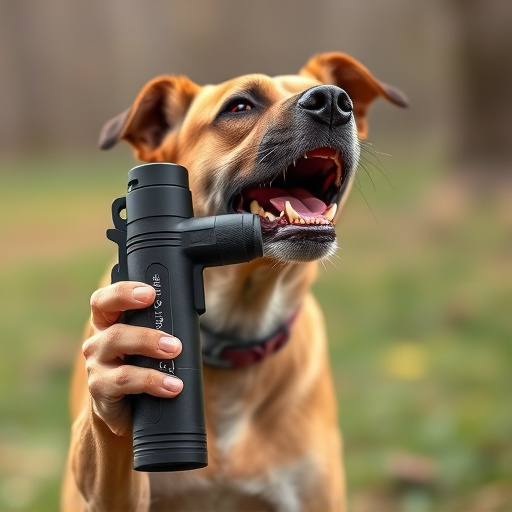Maximum Legal OC Spray for Dogs is a non-lethal defense tool that temporarily incapacitates aggressive canines through capsaicin, the active ingredient in chili peppers. With proper training and handling, it deters dogs without causing lasting harm, offering owners escape time in dangerous situations. Key factors when choosing such spray include potency, dog size, range, and safety features. Effective usage requires comprehensive training for officers, including realistic scenarios, understanding canine behavior, and de-escalation techniques, while adhering to legal concentrations (2% to 5%).
“Unleashing the power of pepper spray into the canine realm brings us to a critical discussion on dog safety and officer protection. In this comprehensive guide, we explore ‘Canine Pepper Spray: A Comprehensive Overview’. From understanding its mechanics to delving into the ‘Maximum Legal OC Spray for Dogs’ and crucial training guidelines, this article is your one-stop resource. Learn how to choose the right spray, ensuring both canine and human safety while navigating the legal framework. Discover the features and benefits that make these sprays essential tools for responsible dog owners and law enforcement.”
- Understanding Canine Pepper Spray: A Comprehensive Overview
- Maximum Legal OC Spray for Dogs: Features and Benefits
- How to Choose the Right Dog Pepper Spray: Factors to Consider
- Training and Safety Guidelines for Using Pepper Spray on Dogs
Understanding Canine Pepper Spray: A Comprehensive Overview
Canine pepper spray, also known as OC (Oleoresin Capsicum) spray, is a non-lethal self-defense tool designed to incapacitate dogs without causing permanent harm. It’s a legal alternative to live force for police and citizens dealing with aggressive canines. The maximum legal OC spray for dogs contains a specific concentration of capsaicin, the active ingredient responsible for the burning sensation associated with chili peppers. This concentration is carefully regulated to ensure safety and effectiveness while adhering to local laws and regulations.
Understanding how canine pepper spray works is crucial. When sprayed onto a dog’s eyes and face, capsaicin irritates the nerve endings, causing temporary blindness, excessive tearing, and pain. This incapacitates the animal long enough for the handler or officer to gain control and de-escalate the situation. It’s important to note that proper training and handling are essential when using canine pepper spray to ensure its effectiveness and minimize risk to both humans and animals.
Maximum Legal OC Spray for Dogs: Features and Benefits
When it comes to maximum legal OC spray for dogs, understanding its features and benefits is crucial for both professionals and owners. This specialized pepper spray is designed to incapacitate and deter aggressive canines temporarily without causing lasting harm. It’s important to note that the potency and usage regulations vary by region, so checking local laws is essential before purchasing or employing such a tool.
The primary advantage lies in its effectiveness; OC (oleoresin capsicum) spray triggers a burning sensation in a dog’s eyes and nasal passages, leading to temporary blindness, irritation, and disorientation. This can provide valuable time for an owner to escape a potentially dangerous situation. Moreover, the non-lethal nature of maximum legal OC spray for dogs makes it a humane alternative to other force options, ensuring the safety and well-being of both animals and humans involved.
How to Choose the Right Dog Pepper Spray: Factors to Consider
When selecting a canine pepper spray, especially one that complies with legal standards, several key factors come into play. Firstly, ensure it’s classified as an OC (Oleoresin Capsicum) spray, which is the maximum legal concentration for dog use. This potency is crucial for effective deterrence without causing excessive harm to your pet or others.
Secondly, consider the size and weight of your dog. A spray designed for smaller breeds may not deliver a strong enough burst for larger ones, so choose one tailored to your canine’s dimensions. Additionally, check the spray’s range: you want it to be effective at distances your dog might encounter during potentially threatening situations. Safety features like child-proof mechanisms and easy-to-use triggers are also beneficial considerations.
Training and Safety Guidelines for Using Pepper Spray on Dogs
When training officers to use pepper spray on dogs, comprehensive safety guidelines must be implemented to ensure responsible and effective application. This includes rigorous practice scenarios that mimic real-world situations, focusing on dog behavior, handler safety, and de-escalation techniques. Officers should learn proper targeting, understanding the effects of OC (Oleoresin Capsicum) spray on canine physiology, and recognizing when to use it as a last resort. Regular refresher courses are vital to maintain proficiency and stay updated with the latest research on non-lethal force against dogs.
The maximum legal concentration of OC spray for dogs varies by jurisdiction but typically ranges from 2% to 5%. Handlers must be educated about the differences in dog breeds, sizes, and sensitivities, as these factors influence the spray’s impact. Safety guidelines should emphasize minimizing exposure to bystanders and animals, proper ventilation during training, and equipping officers with specialized protective gear. Regular assessments and evaluations ensure that training programs are effective and up-to-date, fostering a culture of responsible canine pepper spray usage among law enforcement agencies.
Canine pepper spray, specifically designed for dogs, offers a safe and effective tool for law enforcement and pet owners alike. When choosing the right product, understanding the maximum legal OC spray for dogs is key, ensuring it meets the required standards and regulations. By considering factors like usage guidelines and safety training, you can empower yourself or your community to make informed decisions, promoting public safety and responsible dog ownership.
